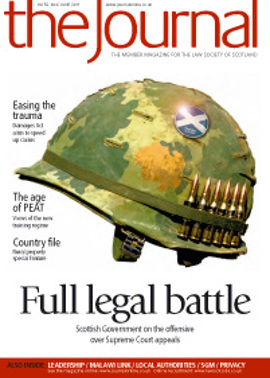Breaking new ground

All change! A new Government in Scotland; new lay members on Council; a new Regulatory Committee; changes to the constitution; and incidentally, a new President and Vice President of the Law Society of Scotland. The Society is on a journey that started long before I became an office bearer and will continue long after I have passed on the seals of office.
And it is quite a journey. The process of comprehensive reform began some time ago and progressed in an extraordinary year of change under Jamie Millar’s leadership. During a whirlwind presidency, Jamie steered the Society and the profession through the passage of the Legal Services (Scotland) Act, the Cadder decision and fallout, Government spending cuts, threats to legal aid, problems with mortgage lenders, and the constitutional reform process. And while the Society’s involvement resulted in important successes, there is no room for complacency.
I want to repeat what I said about Jamie at last month’s special general meeting. Jamie showed integrity, dignity and forbearance and was a credit to himself and the profession during a difficult year. I want to thank him for his guidance and mentoring which I hope will see me through what promises to be another challenging year.
To that end, I am delighted to have the support of Austin Lafferty as Vice President, who will bring his skills in media and communications to the table as well as his knowledge of small firm practice. I am looking forward to working with him, and with Jamie as Past President, during my year of office.
Priorities for action
A career in Government service has taught me that whatever plans are put in place, events – as Harold Macmillan might caution – are likely to crop up and divert attention. With that in mind, I have developed no manifesto or grand plan for my term of office. Instead, I want to focus on a number of key priorities.
Reform of the way the Society works and is organised is already under way, most recently with agreement at last month’s SGM to amend the existing constitution. I want to build on the positive mood of consensus and engagement shown, as we look ahead to bringing back a fully revised and modernised constitution to members at a later date. A review of how best to represent and support in-house lawyers is also ongoing, with an interim report already published and an event to discuss the emerging thinking planned for September.
But much else on the immediate horizon will present new challenges and opportunities. The SGM approved provisions to allow non-solicitor voting members of Council for the first time. Likewise, the Regulatory Committee with 50% non-solicitor membership and a lay convener has now been established. This removes any doubt about ensuring compliance with the Legal Services (Scotland) Act 2010. The Society’s regulatory scheme is now being drawn up in anticipation of applying to become an approved regulator of new business structures, or licensed providers. We are also in the process of implementing our new education and training regime with changes to the route to qualification and CPD.
New ground has been broken with the formation of a Holyrood administration comprising a single party with an overall majority. We know that justice issues will feature centre stage. We are already involved in discussions with Government over the proposed police duty scheme as devised by SLAB. The role of the Supreme Court has also initiated a highly charged debate. The Society raised the important issues around the compatibility of Scots criminal law with the European Convention on Human Rights before the Holyrood election, arguing for a full audit of our criminal laws to ensure the events that led to the Cadder case cannot easily recur. The discussion about the role of the Supreme Court has only served to underline the urgent need for that kind of evaluation to take place.
Alongside any such audit, the Carloway Review has already been established to examine law and practice in light of Cadder. The review published its consultation in April, with the deadline for responses earlier this month. The Society prepared a response and will provide further input as required. In addition, we will continue to represent the interests of solicitors and their clients in responding to legislation introduced during the new session at Holyrood, as well as at Westminster and Brussels. Government spending cuts will also endure as a major issue in the months and years ahead. The Society will argue robustly for the protection of access to justice, while promoting both the profession’s interests and the public interest.
In identifying a theme for the year ahead, I would highlight the crucial importance of moving forward during a period of great change as “one profession”. A profession that engages in lively and constructive debate where views are expressed honestly, openly but respectfully. More importantly, I want that profession led and supported by a strong and vibrant Law Society.
In this issue
- Breaking new ground
- A&A accounts and abatements
- What price privacy?
- Power struggle
- Rural peace?
- Damages for our times
- Grief revalued
- Up to speed?
- Into Africa
- Expenses review opens with invitation on issues
- Law reform update
- From the Brussels office
- Dundee students join advice network
- The learning curve
- Ask Ash
- Guiding hands
- Marriage made in heaven?
- Email on the spot
- One for the accused to prove
- Going for growth
- A brake on termination?
- The colour yellow
- All change on the croft
- Natural justice in play
- Website review
- Book reviews
- A time of opportunity
- Rural property - Who wants to be a green wellie conveyancer?
- Rural property - Buying and selling: pitfalls and problems
- Rural property - In the taxman's sights
- Rural property - Farm tenancies: more changes imminent
- Now we are 10






